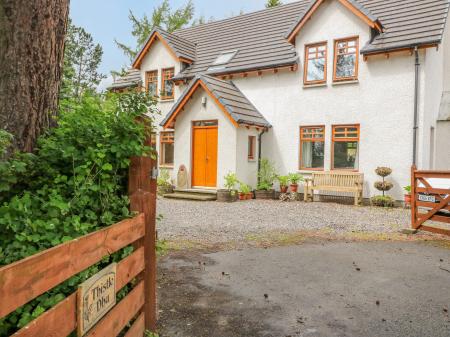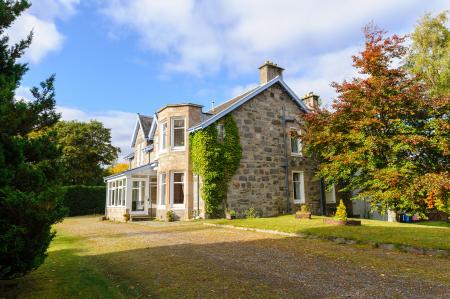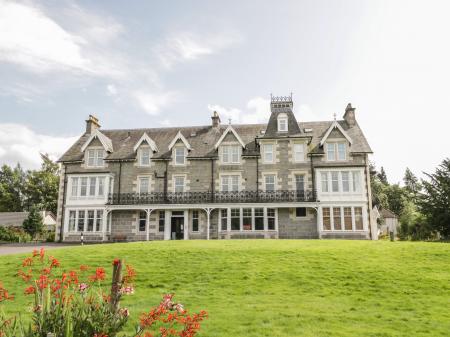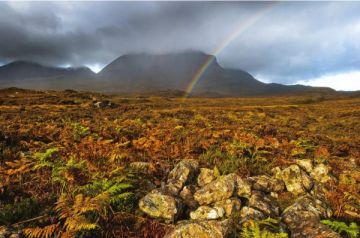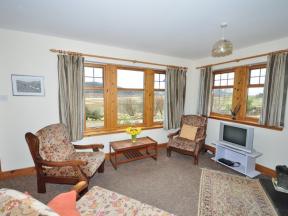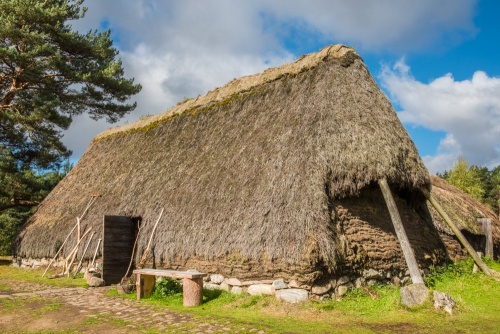
This award-winning visitor attraction shows how people lived, learned, worked, and played throughout the long history of the Scottish Highlands. Learn about Highland culture and how life has changed from the 18th century to the present day. There are often costumed characters on the site, showing how people lived and giving demonstrations of traditional crafts.
History
In 1935 Dr Isobel Grant opened a museum of Highland culture in a church on the island of Iona. By 1944 the collection had outgrown the church and was moved to a site at Kingussie, in the Cairngorms. The museum brought together not only a vast array of cultural material from traditional Highland life over the centuries but acted as a home for traditional buildings, many saved from destruction, taken down, and re-erected on the museum site.
In 1995 the museum relocated to the edge of Newtonmore, where the collection of historic buildings has grown. The collection now includes over 10,000 items, from complete buildings to tools, household accessories, vehicles, and machinery. In 2015 the museum was recognised by Museum Galleries Scotland as a 'Collection of National Significance'.

The historic buildings represent a wonderful array of Highland life, from a traditional Isle of Lewis blackhouse to a school building made of corrugated iron from Kirkhill near Inverness. The school is completely furnished inside to reflect how it looked in 1937.
Baile Gean Township
Perhaps the most interesting part of the museum is a complete Highland township moved here from Easter Raitts in the Spey Valley and re-named Baile Gean, which translates as 'Township of Goodwill'.
The township spans the period from the later Middle Ages through the 18h century and is presented as it would have looked in the year 1700. These crofting buildings were made with timber cruck-frames, and earth walls atop a stone foundation, with a thatched roof. Peat fires burn inside some of the houses, and livestock wander among the buildings.
Here you can see a weaver's house, barn, stockman's house, cottar's house, kiln barn, pigman's house, and much more, laid out as they would have been in their original home. The result is a fascinating glimpse into traditional Highland life.

Outlander at the Highland Folk Museum
The TV series Outlander did a lot to popularise Highland heritage across the world. In episode 5 of season 1 the heroine, Claire, joins a rent-collecting journey to several traditional Highland Communities where she joins the locals in traditional tasks such as 'waulking the cloth', or pounding wool to remove dirt and other impurities. Parts of this episode were filmed in the Baile Gean Township at the Highland Life Museum, and many visitors to the museum are drawn to see the village where filming took place.Other buildings including a 1930s croft house and a replica of the hut used by the Newtonmore curling club, standing beside a curling lake. Then there's a sawmill building from Ardverikie, and a complete Traveller's encampment with washing hung out to dry.
One striking building is a corrugated iron and timber church brought from Leanach, on the Culloden Battlefield. This fascinating building was erected from a kit in 1900. It was declared redundant in 1980 and was moved to Newtonmore in 1987.

See a shinty pavilion beside a shinty pitch where regular games are still played. When we visited the museum a pair of local school teams were playing a league match and it is wonderful to see this traditional Highland sport being played as it has been for centuries.
You can also see the old post office from Glenlivet, a smokehouse, shepherd's bothy, and a farm steading. Delve into workshops used by traditional tradesmen including clockmakers, tailors, smiths, and joiners.
The wonderful thing about the Highland Folk Museum is that it continues to grow and add more rescued buildings, reflecting the traditional Highland way of life.
Museum Highlights
Aultarie Steading
This complex of buildings occupies the east end of the museum site. The buildings are 'native' to the site and where here before the museum moved in. The name Aultarie probably comes from the Gaelic for 'Burn of the Gorge' and applies to both the farmstead and the stream that runs through the site.
The farm was owned by the Balavil Estate and was farmed by the Grant family from the mid 19th century until the mid-20th century. The buildings include three stable buildings, a cattle byre, a barn, and a dairy.
Aultarie Tin Cottage
This small cottage is not, as its name might suggest, made of tin, but is built with a timber frame clad in corrugated iron. The material was known locally as 'crinkly tin'. It was erected by a local joiner in the 1890s and was used by farm workers, or by the Grant family when the rented the main farmhouse to tourists.

Aultarie Railway Halt
This delightful little building was originally a signal box on the line from Inverness to Perth. It is, however, displayed as a waiting room. After it fell out of use on the railway it was used as a summerhouse, then moved to Newtonmore where it became a workshop. It was moved to the museum in 1960.

Aultarie Garage
This corrugated iron building was erected in 1928 and used as a depot for storing motor oil and spirit by the Scottish Oil & Shellmex BP company in Kingussie. From the 1990s the depot was used by the local McCormack's Garage as a workshop.
It is now shown as it might have looked during the 1930s and houses a WWII-era Fordson Model N tractor. Outside the garage is an original Shellmex-BP fuel pump made around 1928.

Smokehouse
This curious little building was used to cure fish and stood on the Fairburn estate near Marybank in Easter Ross. It is made from corrugated iron atop a timber frame. Within is a firebox where oak chips were burned to produce smoke which was drawn up through the floor to a central chamber where the fish was hung. The volume of smoke was controlled by a conical vent on the rooftop.

Cart Shed
Next to the smokehouse is a shed that was part of the original Aultarie farmstead. The building dates to the early 19th century and is cut into the bank, supported on timber posts with drystone walls at each end. Under the corrugated iron roof are carts from the Ardverkie Estate near Laggan. Some date to the early 1900s and have traditional wooden wheels while post-WWII examples use rubber pneumatic tyres.

Glenlivet Post Office
This building has a fascinating history. The post office was built in 1913 by Robert Stuart of Glenlivet when he became the local sub-postmaster. Stuart attached the structure to his house. In 1950 Robert's son Tom took over the sub-postmaster role with his wife Ida. The couple retired in 1996 and the post office moved into a new building.
The museum acquired the post office part of the building in 2000 and moved it to the Newtonmore site where it was faithfully reconstructed, using all the original fittings and furnishings. It is now attached to Aultarie Farmhouse.

Aultarie Farmhouse
This attractive stone house dates to the middle of the 19th century and served as the principal farm residence. The family sometimes rented it out to tourists and would temporarily move into a summerhouse while the farmhouse was in use by the visitors. This was a common practice locally and helped bring in extra income for farm families. The ground-floor sitting room has been recreated as it would have looked in the 1930s.

Kirk's Store
One half of the ground floor of Aultarie Farmhouse is occupied by Kirk's Store, a sweet shop named after the Kirk family who were the last farmers work the farmstead before the museum purchased it. The sweetshop is not simply a recreation; it actually sells sweets and is, naturally, a very popular destination for families! The shop does not recreate a specific historical building but represents the type of shop found all across the Highlands, when many people earned extra income by adding a shop space to their homes.
Shepherd's Bothy and Fank
Near the shop is a shepherd's shelter, or bothy, made mostly from re-used railway sleepers. It originally stood at Presmuchrach near Dalwhinnie. The bothy has two rooms. The main living area crams in a bed, stove, table and chairs as well as the shepherd's tools.
Attached to the bothy is a 'fank', a connected series of holding pens made with drystone walls. The pens helped manage sheep during busy times of the year such as the annual shearing, washing, and marking. One traditional job carried out in a fank was 'smearing', where the sheep were covered in a tarry substance that helped keep insects away and protected against the harsh winter weather. A boiler for heating the mixture stands beside the fank.

Lochanhully House
This wooden house was erected around 1922 by the brothers Rhynie and Joe Rose for their father Duncan, a shoemaker. It was built from 90 pine trees from the Seafield Estate. The house was given to the museum by Mr Rose's great-grand-daughter along with many of its original contents. It is furnished as it would have been in the 1950s.

Loom Shed
Just down the hill from Lochantully House is a shed built to house a Hattersley loom, and illustrates the role of the Harris tweed industry to crofting families in the Hebridean islands. The Hattersley hand loom replaced traditional hand-made looms. When Lord Leverhulme introduced this machine-made loom to the Western Isles in the early 20th century it revolutionised the traditional hand-weaving industry by allowing weavers to create more complex patterns.

Blackhouse
Next to the loom shed is a traditional blackhouse such as would have been used by the weavers. These blackhouses were especially common on the Isle of Lewis. They were built low to the ground to counter the effects of the bitterly cold Arctic winds, with rounded corners and thatched roofs held down by ropes and anchoring stones.
The blackhouse is divided into three sections, with a cattle byre at one end, a 'ben', or good room at the other, and in between was an area where all cooking and sleeping was done. This area was heated by a central fire. Smoke from the fire was simply allowed to drift upwards and filter out through the roof. As you can imagine, this area would have often been filled with smoke and the pungent aroma of burning peat.

Boleskin Shinty Pavilion
Opposite the blackhouse is a shinty field, where this traditional Highland sport is still played regularly. At one end of the field is a 1930 pavilion built by the British Aluminium Company Works at Foyers, to help their workers enjoy recreational activities.
There is a display on the history of shinty and its importance to the Highlands, with a recreated dressing room and a display on the dramatic events of 13 February 1941 when the German air force raided the works. Large dents made by flying shrapnel from the bombing can still be seen in the pavilion roof.

Daluaine Summerhouse
Near the shinty pavilion is this delightful little summerhouse made from old railway sleepers. It was made around 1900 but is furnished to reflect the 1950s. Summerhouses like this were used by local families when they rented out their main house to tourists. One original feature is a fireplace made from yellow bricks by the Bathville Brick & Fire Clay Works.

Highland Cottage
This attractive stone and turf cottage near the museum entrance was built around 1800 and represents an intermediate phase between the earlier turf cottages in the Township area and the stone and lime mortared cottages common in the late 19th century. It features a main living area with a box bed, a 'good room' and a larder.
The cottage is built using a cruck frame, that is, with timbers set in slots in the drystone walls. The roof is a combination of turf, cabers, and heather thatch. The main difference you can see between this type of cottage and the earlier Township cottages is that there is a fireplace set against one wall rather than a central hearth.

Knockbain School
This late 19th-century kit school was made of timber and corrugated iron pieces and assembled at Kirkhill, near Inverness. The school contains a classroom, teacher's room, and a toilet. It was erected to serve deprived children from Glasgow who were relocated to the Highlands where it was thought they would have a better quality of life.
The school is shown as it would have been in 1937, with its original cast iron range, which served both the practical purpose of heating the schoolroom but was also the focus for domestic science classes. See original school books, maps, school bells, and a Lochgelly tawse (a strap used for disciplining unruly students). One oddity is a case full of hardened chewing gum which had to be chipped off the desks.

Leanach Church
This striking red and white building originally stood on the Culloden battlefield just outside Inverness. It was erected as a Mission Hall by the Free Church and the Church of Scotland on land rented from a Leanach farmer.
When the land reverted to the owners in the 1980s the building was taken apart, moved to the museum site, and reassembled. The original building was supplied in kit form by the Spiers Company of Glasgow in 1924 and is made of timber and corrugated iron. It would originally have been lit by oil lamps. The pedal organ is original as is the communion table.

Craid Dhu Tweed Cottage
This large structure was built around 1900 as a summerhouse for Craig Dhu but was later used as a shop and workshop by a Newtonmore weaver. See the loom where the weaver, Mr Gowans, produced wool, tartans and knitwear. The shop fittings are original and include the shelves, counter, and original woollen goods made on the loom. The cottage is supported by a timber frame and shown as it would have looked in the 1950s.

MacPherson's Tailor Shop
Near the Tweed Cottage is a tailor shop and workshop used by Donald MacPherson. Donald's father Alexander built the shop for him after Donald returned wounded from WWI. When Donald closed the shop in the 1940s it became a sheep shelter and then a store. It is shown as it would have looked in the 1930s. The workshop fireplace is original, but the cast iron stove came from Grantown on Spey.

Clockmaker's Workshop
Another workshop, this time for an amateur clockmaker named Alexander MacIntyre from Nairn. MacIntyre was a bicycle salesman and repairman by trade but had a passion for clocks of all kinds. He set up this 'study; in his garden and here he built and repaired clocks. The workshop contains several machines and specialised jigs invented by MacIntyre. One of his inventions was a hidden locking mechanism for the workshop door.

Joiner's Workshop
This two-storey building dates to 1904 and stood on King Street in Kingussie. It housed the joinery business run by Donald Fraser, which handled all kinds of work from making coffins to repairing carts. The building went out of use in 1996.
It has been furnished to reflect the 1930s, with the ground floor used as a timber store and the first-floor work area filled with workbenches and tools. There is a machine shop area on the ground floor with a Lister petrol engine supplying power for a band saw.

Pinewoods
From the Joiner's Workshop you walk west into a beautiful area of pine woodland. This area dates to the 1920s when pine seedlings were planted on part of a golf course with an eye to developing a commercial timber business. The pinewood is home to red squirrels, woodpeckers, and owls.
Traveller's Encampment
As you walk through the pinewoods you come to a Traveller's encampment, showing how a typical Romany family would have lived, with a temporary tent, stone hearth area, and washing line hung with clothes. Traveller's camps were often found on the edge of towns and villages.

Newtonmore Curling Club Hut
Near the Traveller's Camp is a lovely curling pond, sheltered by tall pine trees. at one edge of the pond is a replica of the original Newtonmore Curling Club hut, made from re-used railway sleepers. The hut provided shelter for curlers attending bonspiels (curling tournaments). Inside the hit are several examples of old curling stones made from granite.

Ardverikie Estate Sawmill
This water-powered mill was erected in Nethybridge in the 1860s. It was moved to the Ardverikie site near Laggan in 1937. A 12-foot diameter overshot waterwheel sent power to the main saw, producing rails, fence posts, boards and firewood. In the 1940s the waterwheel was replaced by a Fordson tractor running on paraffin, powering a pulley system. The milling machinery is all original.

This is just a brief overview of the major buildings you can see at the Museum. You can easily spend an entire afternoon exploring the site. The museum is spread out over a large area, well over a mile from one end to the other, so there are regular, free, coach rides available to take visitors from one end of the site to the other if you'd like to put your feet up for a while.
The Highland Folk Museum is simply outstanding and well deserves a special trip to see.
